There is a quiet and cozy resort town of Dambulla in Sri Lanka – where you can relax and get away from the ubiquitous modern bustle. The main attraction of this resort is the Dambulla Temple-it is located on the southern outskirts of the city, on a mountain 350 m above sea level.
To make the tour of the temple an interesting event, and not just walking through the grottoes among the numerous sculptures, you will need some knowledge and create a certain mood. This will help you better experience the atmosphere of an unusual place in Sri Lanka and greatly enhance the impression of everything you see.
What is the Dambulla temple complex?

To begin with, it is worth understanding that contrary to popular belief, this famous landmark is nothing more than two completely different temples. The first, the Golden Temple of Dambulla – is a relatively new building, which is a little more than 250 years old. The second, the Cave Temple, is an ancient monastery complex, the age of which scientists still can not determine exactly, naming only an approximate figure: 22 centuries.
These temples in Sri Lanka were combined into one complex, which was recognized as a UNESCO World Heritage Site.
The Golden Temple is located under the mountain, near the road, parking for cars and a bus stop. This building houses a variety of administration offices and a Buddhist Museum. The museum’s exposition consists mainly of gifts presented to the temple in different periods, photographs of the monastery’s leaders and information about them, as well as sculptures of the Buddha and paintings with the history of his life.
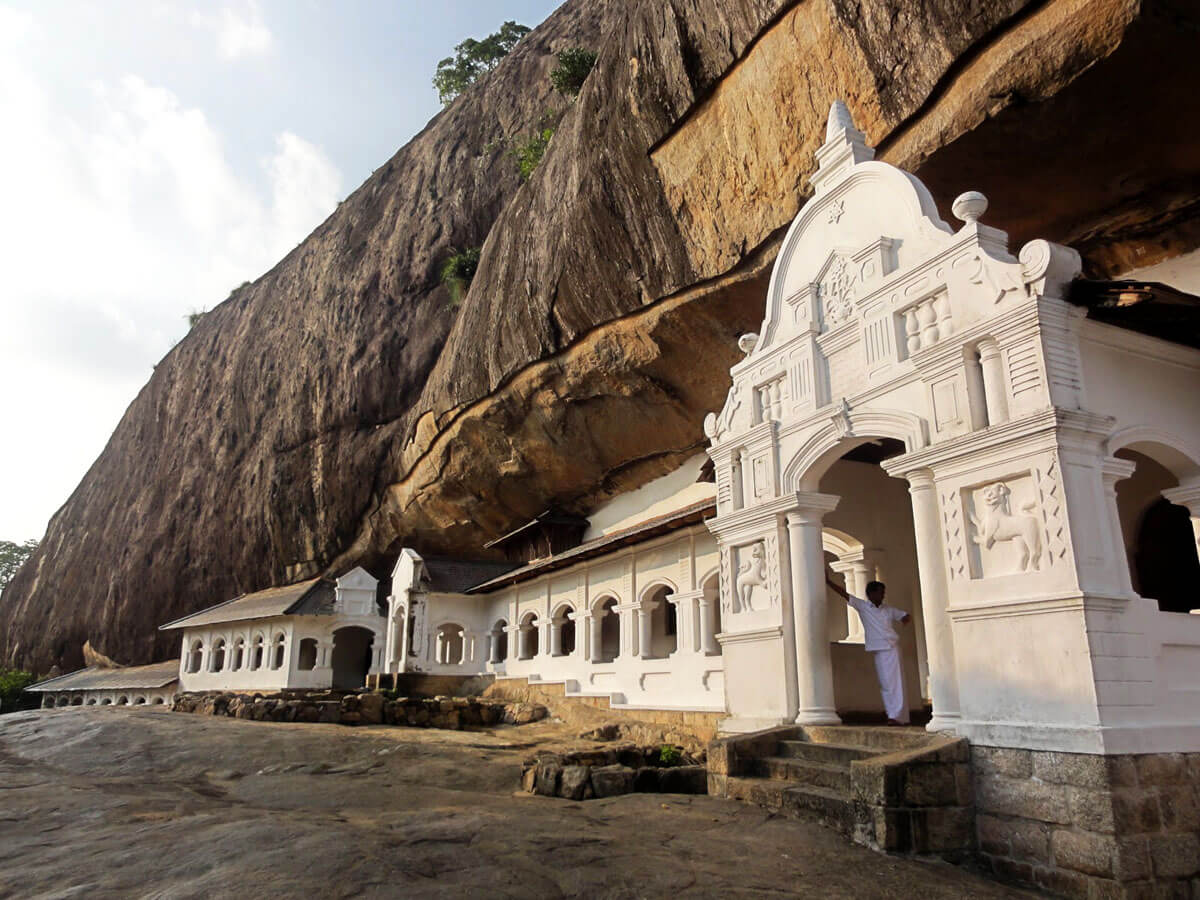
To get to the Cave Temple of Dambulla, you need to climb the steps. This temple consists of 5 main caves that are open to tourists for inspection, as well as a large number of grottoes that are of no interest due to the lack of paintings, sculptures and other valuables. Steps lead to the platform, from which the snow-white colonnade is located under the sheer wall, and behind it the temple caves are located:
- Deva Raja Vihariya (temple of the King of the Gods).
- Maha Raja Vihariya (Temple of the Great King).
- Maha Alut Viharaya (Great New Temple).
- Pacchima Viharaya (Western Temple).
- Devana Alut Viharaya.
And now a little information about each of them.
Deva Raja Vihariya
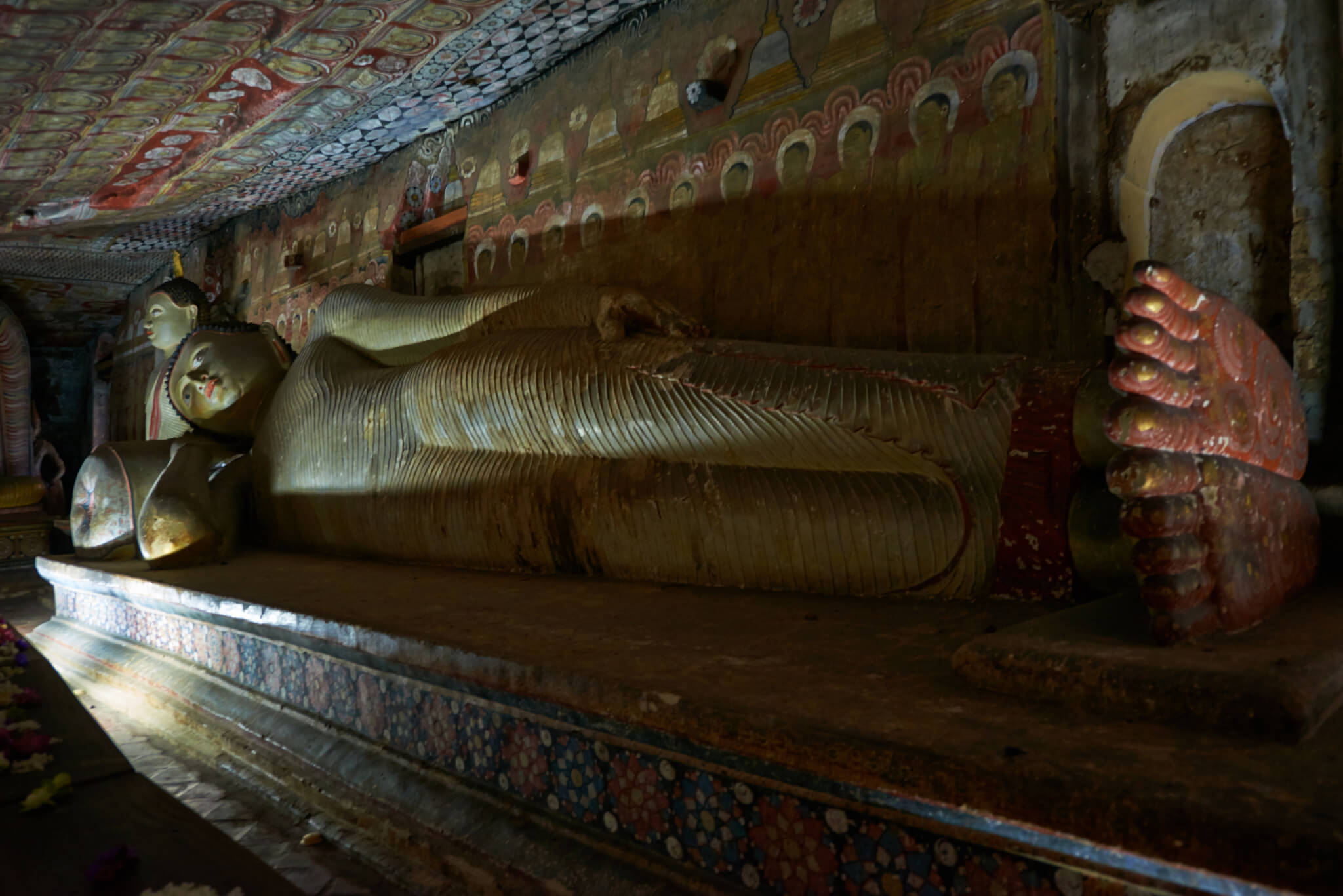
The first thing a person who enters this cave sees is a huge 14-meter sculpture of a reclining Buddha, which occupies most of the space. It is cut from natural rock, and at the back along its entire length, it remained connected to the rock.
There are 5 more statues in this cave. In the northern part of it there is a small figure of the god Vishnu, and in the southern part there is a figure of Ananda (disciple of the Buddha).

There is little space in this sanctuary. Pilgrims and tourists who want to take a good look at everything are forced to be very crowded.
In Deva Raja Vihariya, pilgrims constantly gather, and attendants bring offerings of food to the Buddha. There are always candles and incense burning here, because of which the walls are very smoky and the painting is almost indistinguishable. Nevertheless, on the left side of the Buddha, though poorly, but you can see some episodes from his life.
Maha Raja Vihariya

This most spacious, the royal cave, reaches a length of 52.5 m, a width of 23 m, while the height, starting from 6.4 m, gradually decreases and in the depth of the cave, its vault turns into an arch.
At the entrance there are stone statues of gatekeepers on both sides.
In total, there are 40 statues of the Buddha in meditation and 10 statues of the Buddha standing in this sanctuary. The main sculptures of the cave are a statue of Buddha standing under an arch shaped like a dragon Toran. The figure of the Buddha is placed on a round pedestal made in the form of a lotus flower.
On the right side of the entrance, on a round wide pedestal, stupas are installed, the height of which is 5.5 m. Around this pedestal there are 4 figures of Buddha sitting on cobra rings.
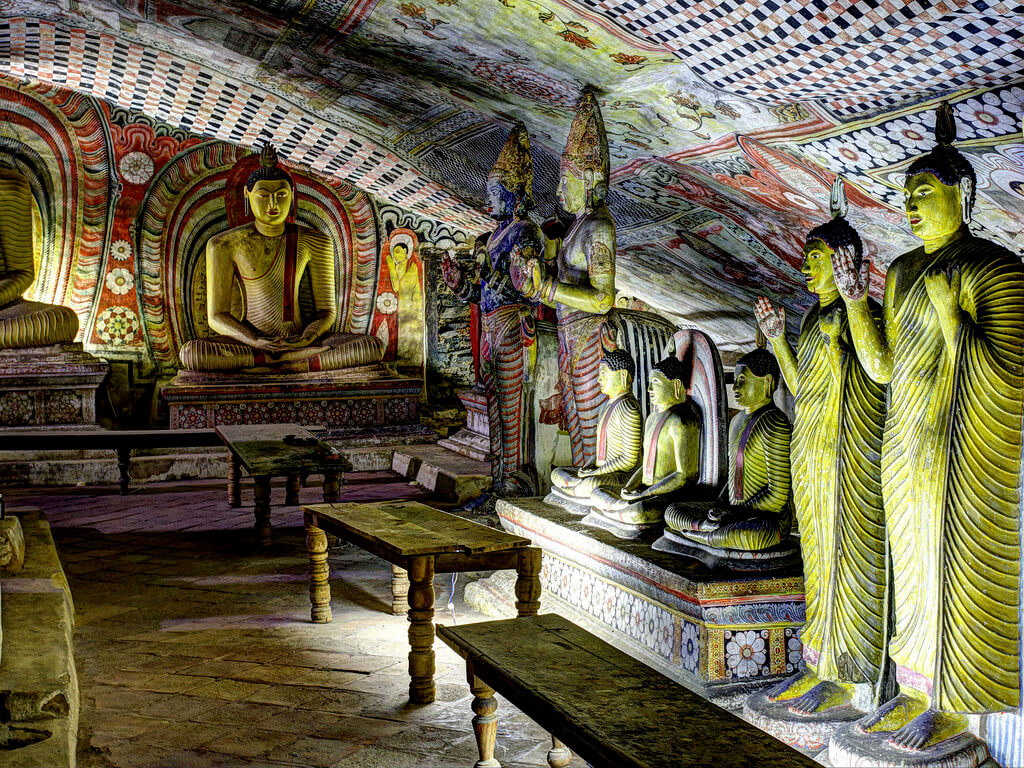
All the walls and vaults of the cave are painted with images of scenes from the life of the Buddha, and for this purpose bright, mostly yellow colors were used.
Only in Maha Raja Vihariya can you observe a real natural miracle: water collects and flows along the walls, without reacting to any laws of nature. Surprisingly, it tends to go up the walls, and from there it drips into a bowl of gold – it is around this bowl that the figures of the Buddha, who is in a state of deepest meditation, stand!
Scientists who study the history of religion, this cave in Sri Lanka is also very interesting. After all, in the room you can see sculptures of the Buddha and nearby figures of ancient deities revered by people even before the emergence of Buddhism.
Nuwara Eliya is the “city of light” in Ceylon.
Maha Alut Viharaya
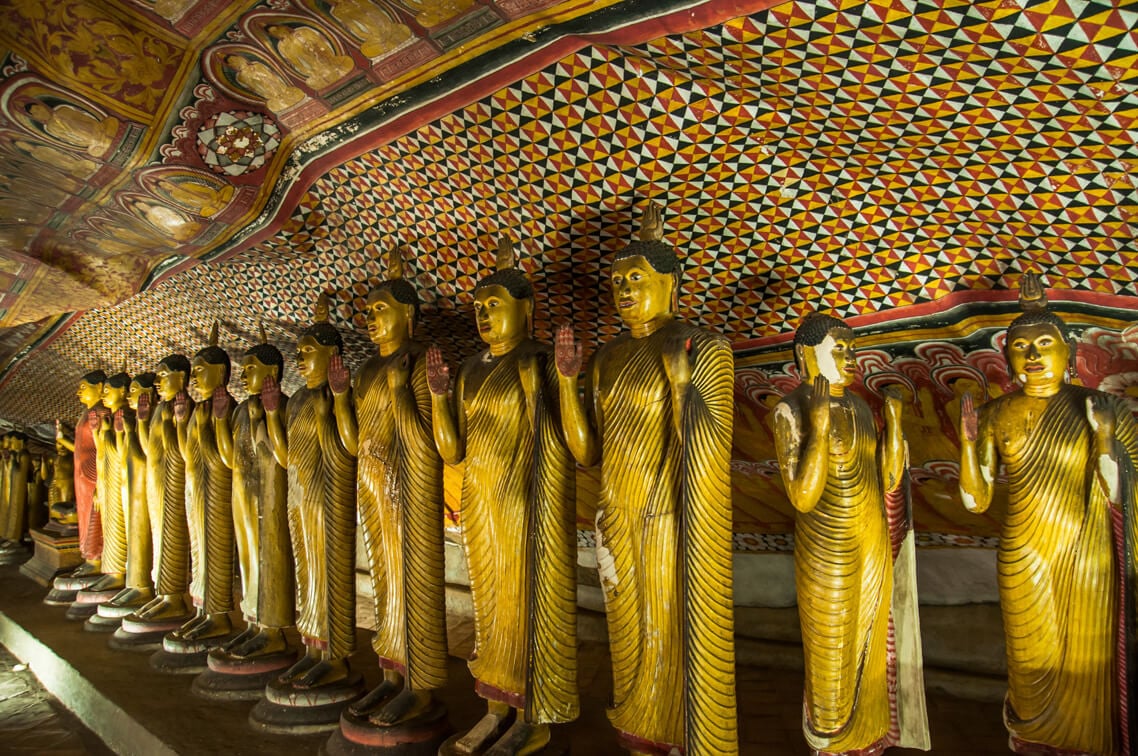
This cave was designed as a sanctuary in the 18th century, when Kirti Sri Rajasinha, the last king of Kandy, ruled. At the entrance to the cave is a statue of this king – the last ruler, who contributes significant sums to the maintenance of the Cave Temple.
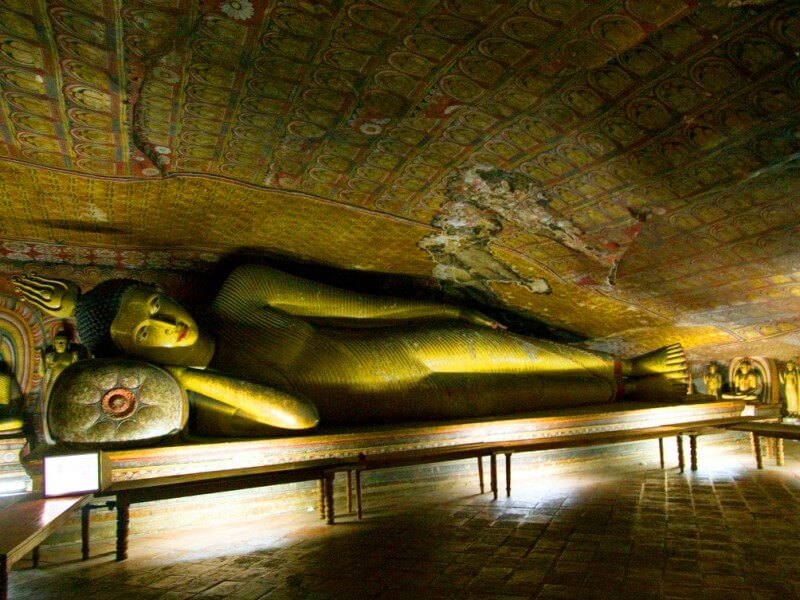
All the vaults of the sanctuary (length 27.5 m, width 25 m, height 11 m) are covered with bright frescoes – there are about 1000 images of the Buddha looking at visitors from a height. There are also a lot of sculptural images of the Buddha standing and sitting in the lotus position here – 55 pieces. And in the very center is a huge 9-meter statue of the Buddha sleeping on a bed – it is very similar to the statue from the Deva Raja Vihariya cave. Because of so many Buddhas painted in bright yellow, a person has a strange feeling of moving into some other reality.
Pacchima Viharaya

The Pacchima Viharaya cave of the Dambulla Temple in Sri Lanka is the most modest when compared to the rest. Its length is 16.5 m, width 8 m, and the vault, which drops sharply in the depth of the cave, reaches a height of 8 m.
There are 10 Buddha sculptures in this sanctuary. The main figure, depicting the Buddha in a meditation pose and decorated with a dragon, is carved from the same rock that makes up the cave. All other statues are arranged in a row on both sides of the main image.
In the center of the cave is the Soma Chaitya stupa, which was once used as a safe for storing jewelry.
Devana Alut Viharaya
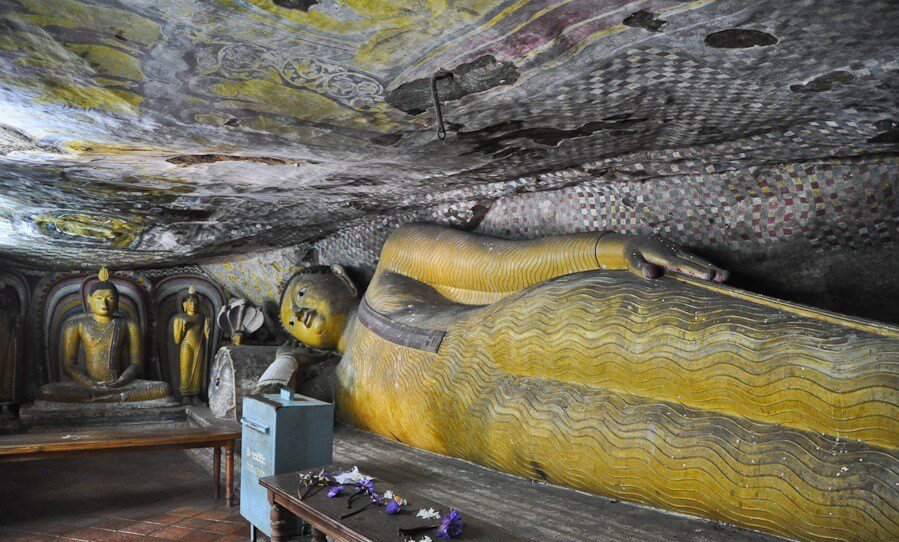
Until 1915, in Sri Lanka, this cave was used as a warehouse, but after restoration, it was returned to its sacred purpose. In this most colorful and colorful temple, there are 11 statues of Buddha, as well as other figures.
Opening hours, ticket prices
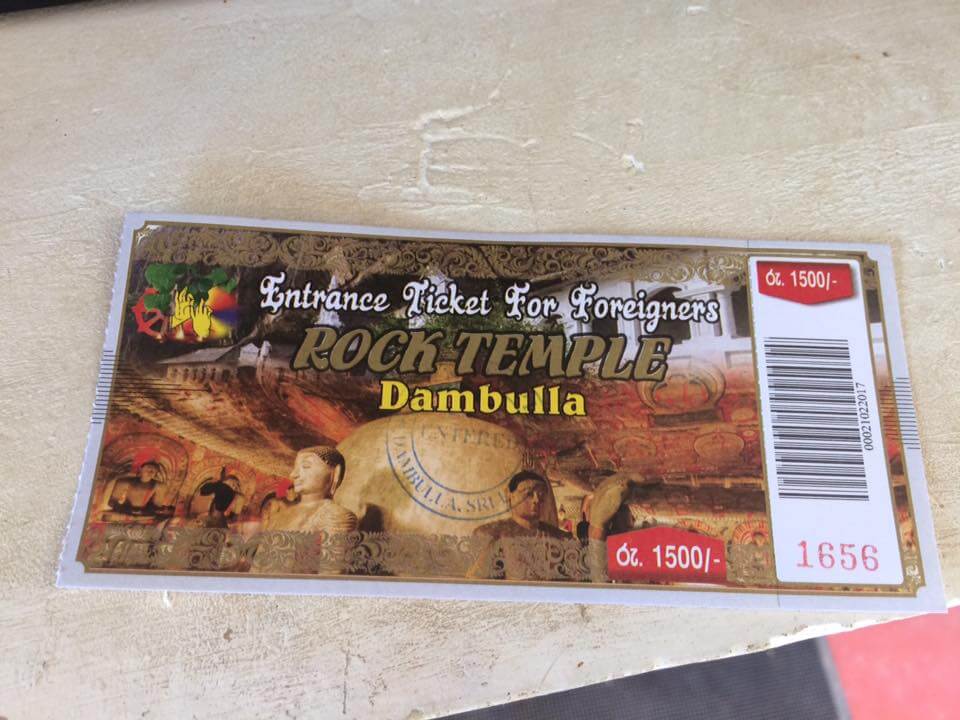
- The ticket offices located to the right of the Golden Temple decorated with a majestic Buddha Statue are open from 7: 30 to 18: 00, with a break from 12: 30 to 13: 00. If you go straight up to the Cave Temple, then you will need to go back to buy a ticket.
- A ticket to stay at the Dambulla Temple complex in Sri Lanka costs 1,500 rupees, or approximately$7.5.
- Parking is also located here, it is impossible not to notice it – it is completely free, although enterprising Sri Lankans can request 50-100 rupees. Sometimes it is worth paying for them, for example, for the safety of helmets that remain on the handlebars of bikes or motorcycles.
What is important for a tourist to know
- It is advisable to come to visit the temple complex in the morning, as later, in the heat, it will be harder to climb to the caves. In the rain, you need to be careful, because the steps that lead to the caves will be slippery.
- When visiting Sri Lankan temples, you should not forget to observe some local traditions. In many ways, this applies to clothing – it should cover the shoulders and knees. The men were asked to remove their headdresses.
- Before entering the temples, you must take off your shoes. At the entrance, before ticket control, there is a shoe storage room (the service costs 25 rupees), although shoes can be left just like that, but then no one will be responsible for their safety. By the way, the floor in the caves can not be called pleasant, and in order not to go barefoot, you can take socks with you.
- The Dambulla cave Temple in Sri Lanka and the photos on its territory are a special issue. You can not take photos with your back to the Buddha, as this is considered a huge disrespect, especially if we are talking about active temples.
How to get to the temple complex
The town of Dambulla is located at the intersection of the main highways of the island, so the Cave Temple can be visited during any trip in Sri Lanka. You can get to this city by bus, taxi or by rented car.
Dambulla is connected by bus routes to Colombo and all the cities that make up the “Cultural Triangle of Sri Lanka” (Kandy, Sigiriya, Anuradhapura, Polonnaruwa). You don’t need to buy a ticket in advance, because buses run frequently – but only during the day, there are no flights at night. The city bus station, where buses arrive and leave, is close to the Dambulla Cave Temple: a 20-minute walk, but you can take a tuk-tuk for 100 rupees. There are vehicles passing by the temple, so you can get off right there.
So, how to get to the Golden and Cave Temple in Dambulla.
From Colombo
By car, take the A1 Colombo-Kandy highway to Varakapola, then transfer to the A6 Ambepyusa-Trincomalee highway and follow it to Dambulla. To get to the Cave Temple, you need to take the A9 Kandy – Jaffna highway and drive along it for 2 km. The total length of the road is 160 km, and the journey time is about 4 hours.
Buses from Colombo to Dambulla depart from Pettah Central Bus Station. Flights that go towards Trincomalee, Jaffna and Anuradhapura are suitable, and you need to choose a bus whose number starts at 15. But before boarding, you need to check whether this transport passes through Dambulla.
The journey takes 5 hours. Tickets for some buses can be booked online at <url> www.busbooking.lk, you can also view the schedule and ticket prices here.
There is another option – go to Kandy, and from there get to Dambulla.
From Kandy
The trip by car will take about 2 hours. If you follow the A9 Kandy – Jaffna highway 75 km north, you will get directly to the Golden Temple, which stands to the left of the road.
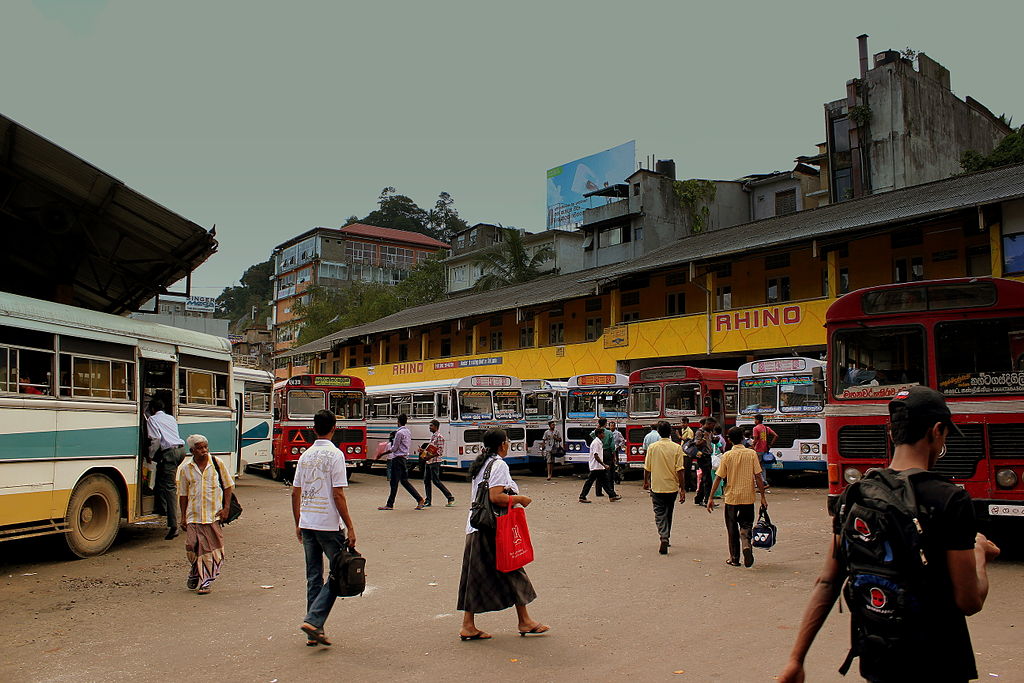
A bus ride is the cheapest way to get to the temples of Dambulla – it costs 70 rupees ($0.5). You can take any flight that goes towards Jaffna, Dambulla, Trincomalee, Habarana, Anuradhapura.
Another way to get from Kandy to Dambulla is to arrange with a local tuk-tuk driver. Such a trip will take an average of 2 hours, and it will cost from 3,500 rupees ($18.5) and more.
From Veligama, Galle, Matara, Hikkaduwa
Trips from the southwestern and southern parts of the island of Sri Lanka will be more challenging, and it makes sense to think about seeing a few attractions. The fastest way to get to Dambulla is via Colombo. Since the eastern part of Sri Lanka does not have a very well-developed road network, and the roads go through the mountains, the road will take a long time.
By car, you need to follow the E01 highway, which turns into E02, to Colombo, then move to the A1 highway, and go as described in the item “From Colombo”. Colombo is approximately a 1-hour drive away. Please note that the E01 and E02 expressways are paid-750 rupees ($4).
The best way to get to Dambulla Temple is by taking an express flight to Maharagama (a suburb of Colombo). This trip will cost $ 3.5 and will take 1.5 hours. After that, you need to take bus 138 to Colombo Central Bus Station-the ticket price is$ 0.25, the journey time is about half an hour. How to go further, read the recommendations from the point “From Colombo”.

